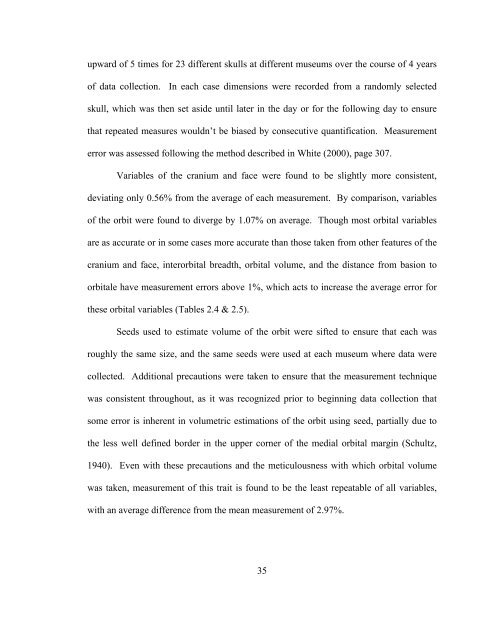modern variation and evolutionary change in the hominin eye orbit
modern variation and evolutionary change in the hominin eye orbit
modern variation and evolutionary change in the hominin eye orbit
Create successful ePaper yourself
Turn your PDF publications into a flip-book with our unique Google optimized e-Paper software.
upward of 5 times for 23 different skulls at different museums over <strong>the</strong> course of 4 yearsof data collection. In each case dimensions were recorded from a r<strong>and</strong>omly selectedskull, which was <strong>the</strong>n set aside until later <strong>in</strong> <strong>the</strong> day or for <strong>the</strong> follow<strong>in</strong>g day to ensurethat repeated measures wouldn’t be biased by consecutive quantification. Measurementerror was assessed follow<strong>in</strong>g <strong>the</strong> method described <strong>in</strong> White (2000), page 307.Variables of <strong>the</strong> cranium <strong>and</strong> face were found to be slightly more consistent,deviat<strong>in</strong>g only 0.56% from <strong>the</strong> average of each measurement. By comparison, variablesof <strong>the</strong> <strong>orbit</strong> were found to diverge by 1.07% on average. Though most <strong>orbit</strong>al variablesare as accurate or <strong>in</strong> some cases more accurate than those taken from o<strong>the</strong>r features of <strong>the</strong>cranium <strong>and</strong> face, <strong>in</strong>ter<strong>orbit</strong>al breadth, <strong>orbit</strong>al volume, <strong>and</strong> <strong>the</strong> distance from basion to<strong>orbit</strong>ale have measurement errors above 1%, which acts to <strong>in</strong>crease <strong>the</strong> average error for<strong>the</strong>se <strong>orbit</strong>al variables (Tables 2.4 & 2.5).Seeds used to estimate volume of <strong>the</strong> <strong>orbit</strong> were sifted to ensure that each wasroughly <strong>the</strong> same size, <strong>and</strong> <strong>the</strong> same seeds were used at each museum where data werecollected. Additional precautions were taken to ensure that <strong>the</strong> measurement techniquewas consistent throughout, as it was recognized prior to beg<strong>in</strong>n<strong>in</strong>g data collection thatsome error is <strong>in</strong>herent <strong>in</strong> volumetric estimations of <strong>the</strong> <strong>orbit</strong> us<strong>in</strong>g seed, partially due to<strong>the</strong> less well def<strong>in</strong>ed border <strong>in</strong> <strong>the</strong> upper corner of <strong>the</strong> medial <strong>orbit</strong>al marg<strong>in</strong> (Schultz,1940). Even with <strong>the</strong>se precautions <strong>and</strong> <strong>the</strong> meticulousness with which <strong>orbit</strong>al volumewas taken, measurement of this trait is found to be <strong>the</strong> least repeatable of all variables,with an average difference from <strong>the</strong> mean measurement of 2.97%.35
















